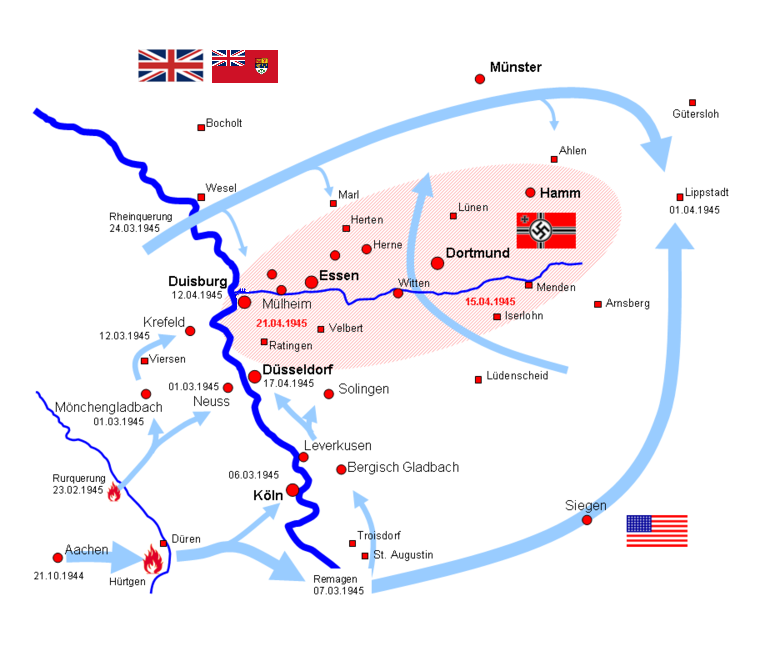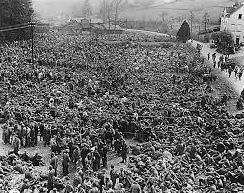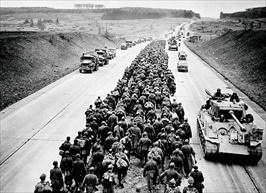U.S. TROOPS ENCIRCLE GERMAN ARMY IN RUHR POCKET
Ruhr Pocket, Northwestern Germany • April 14, 1945
In the spring of 1945 senior leaders of the Third Reich were on edge. On Germany’s Eastern Front, the tracks of Soviet mechanized armor and the boots of their infantry could be heard approaching the outskirts of the epicenter of Nazism, Berlin. On the Western Front, elements of the U.S. First Army under the overall command of Gen. Omar Bradley’s U.S. 12th Army Group had succeeded in establishing a bridgehead on the east bank of the Rhine River after capturing the Ludendorff Bridge at Remagen, 35 miles/56 kilometers south of the cathedral city Cologne, on March 7, 1945. First Army soldiers got busy advancing northward into the enemy’s heavily populated military-industrial heartland, the Ruhr, defended by German Field Marshal Walter Model’s Army Group B. Their advance formed the southern pincer of the Ruhr envelopment (see map below). The northern pincer was formed by the U.S. Ninth Army, since the Battle of the Bulge (December 16, 1944, to January 25, 1945) assigned to British Field Marshal Bernard Law Montgomery’s 21st Army Group. Days before, on March 23–27, 1945, Monty’s British-Canadian-American forces had crossed the Lower Rhine in the Wesel area in Operations Plunder and Varsity. Thus the lead elements of 2 U.S. armies, First and Ninth, stood ready on March 28, 1945, to begin a massive envelopment of upwards of 400,000 German troops in the so-called Ruhr Pocket.
The reduction of the encircled enemy by the U.S. Ninth Army, reattached to Bradley’s 12th Army Group, began at the top of April when lead elements of the 2 U.S. pincers converged near Lippstadt in the eastern Ruhr. Troops from the U.S. First Army, 90 miles/145 kilometers to the south, solidified the ring around Army Group B some 4 days later. Outmanned, outgunned, low on ammunition and fuel, the Germans skillfully delayed or resisted the American advances for days. But on this date, April 14, 1945, the U.S. First and Ninth Armies managed to split the Ruhr Pocket into an east part and a tinier west part.
The turning point in combat came the same day. Having lost contact with its units, the German 15th Army, the larger of the 2 armies that comprised Model’s Army Group B, capitulated. Model dissolved the whole of his army group the next day, April 15. Then he ordered noncombatant personnel, Hitler Youth units, and the Volkssturm, a ragtag home guard consisting of 16- to 60‑year-olds who had escaped being swept up by understrength units of the Wehrmacht (German armed forces), to discard their uniforms and makeshift armbands and head home as best they could.
On April 16 the remnants of 2 armies, 5 corps, and 19 mostly weaponless Wehrmacht divisions surrendered en masse to U.S. forces after Germany’s leader for the past 15 years, Adolf Hitler, denied Model’s request for either an airlift of weapons and other supplies (deemed too risky) or permission to break out of “Festung Ruhr,” Fortress Ruhr (ordered to stay put). Organized military resistance in the Ruhr Pocket ceased on April 18. Unwilling to submit to Allied or German arrest—his army group had been denounced by Hitler associate Joseph Goebbels as traitors—Model, the monocled model of a proud Prussian officer, died by his own hand on the afternoon of April 21, 1945, 9 days before his commander-in-chief did the same in the Fuehrerbunker under the rubble of his diabolical Thousand Year Reich.
Climactic Battle of the Ruhr Pocket, March 28 to April 18, 1945
 |
Above: Map of the Ruhr Pocket. By April 4, 1945, the encirclement was complete. Among the millions of desperate, displaced, and destitute Ruhr civilians trapped inside the pocket were the German 15th Army in the east and, in the west, the 5th Panzer Army, both armies under the overall command of Field Marshal Walter Model, head of Army Group B. Half of Model’s soldiers fielded infantry weapons, the other half pistols only. The soldiers had food provisions for 3 weeks, notwithstanding Hitler’s expectation that Model’s armies would hold out for months in their fortified stronghold and tie up hundreds of thousands of Allied soldiers with promised help from the German 12th Army, which was never available, tied up at the moment in trying to break the Soviet siege of the Reich capital. By April 11 the egg-shape pocket, originally 35 by 75 miles/56 by 121 kilometers wide, had fractured in the east, shriveling a third or more. It was half that size 3 days later when U.S. First and Ninth Armies bisected the egg in the Hagen-Witten area, which lay between Essen and Dortmund. On April 16 the remnants of mostly weaponless fighters surrendered to U.S. forces, encouraged by American loudspeakers calling on German soldiers to give up the last-ditch fight of a war long lost. Some of the younger and older men trekked home. The bulk of the fighting men, between 317,000 and 325,000, were herded into temporary POW enclosures near Remagen.
 |  |
Left: Part of an estimated group of 82,00 German soldiers captured in the Ruhr Pocket cleanup by the U.S. XVIII Airborne Corps, near Gummersbach, Germany, April 17, 1945. Gummersbach is 20 miles/47 kilometers south of Luedensheid and 20 miles/47 kilometers west of Levenkusen on the map. The XVIII Airborne Corps had planned and executed Operation Varsity the month before as part of Field Marshal Montgomery’s amphibious and airborne dash to the east bank of the Lower Rhine.
![]()
Right: Thousands of German prisoners of war march between lanes of a German autobahn to a POW camp while their Allied captors speed past in tanks, trucks, and jeeps, May 4, 1945. The number of captives, over 300,000 men including 30 generals, was twice what U.S. Army intelligence had estimated. It was a huge achievement. In the Battle of the Ruhr Pocket the U.S. Army had ripped out the heart and guts of the Wehrmacht in the West. Coming so closely on the unconditional surrender of the German military on May 7 and 8, 1945, that achievement, which cost 10,000 U.S. casualties, unfortunately dwells in the shadows of VE Day.
Battle of the Ruhr Pocket: Conquest of “Hitler’s Armory.” (Skip first 45 seconds)
![]()

 History buffs, there is good news! The Daily Chronicles of World War II is now available as an ebook for $4.99 on Amazon.com. Containing a year’s worth of dated entries from this website, the ebook brings the story of this tumultuous era to life in a compelling, authoritative, and succinct manner. Featuring inventive navigation aids, the ebook enables readers to instantly move forward or backward by month and date to different dated entries. Simple and elegant! Click
History buffs, there is good news! The Daily Chronicles of World War II is now available as an ebook for $4.99 on Amazon.com. Containing a year’s worth of dated entries from this website, the ebook brings the story of this tumultuous era to life in a compelling, authoritative, and succinct manner. Featuring inventive navigation aids, the ebook enables readers to instantly move forward or backward by month and date to different dated entries. Simple and elegant! Click 











